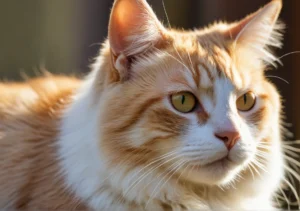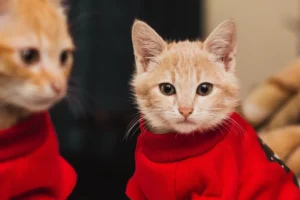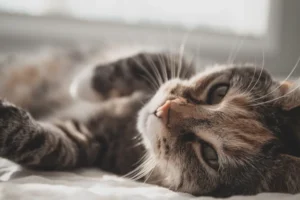Every cat owner knows the drill: you buy the fanciest, comfiest pet bed, only to find your feline friend snoozing in the box it came in. Cats are mysterious creatures, especially when it seems like they’re dreaming of catching mice on a cloud made of your freshly laundered clothes.
In this post, you’ll unlock the secrets behind your cat’s sleep habits and what they’re trying to tell you with every purr and twitch.
Key takeaways:
- Cats’ loaf, side-sleeper, and belly-up positions indicate varying levels of comfort and security, providing insight into their emotional state.
- Regular, peaceful sleep and consistent routines contribute to a cat’s health—alterations in sleep patterns may be a sign to consult a vet.
- Enhancing a cat’s sleep involves creating a safe spot, maintaining the right temperature, and establishing a bedtime ritual tailored to their preferences.
Why Does My Cat Sleep So Much?
If you’ve ever found yourself wondering if your feline friend is sleeping too much, rest assured, their love affair with sleep is perfectly normal.
Cats are naturally inclined to sleep a hefty chunk of their day away—typically about 12-16 hours. This is a throwback to their ancestral hunting habits where conserving energy for the big chase was key. Plus, being crepuscular critters means that they’re most active during the twilight hours—dawn and dusk.
For kittens and older cats, the snooze bar gets hit even more. These age groups can clock in up to 20 hours of sleep a day! It’s all part of the natural rhythm of growing and aging.
What Do Different Sleeping Positions Mean?
Have you ever caught your cat in a quirky sleeping position and wondered what’s up with that? Each pose can be a tell-tale sign of how your cat’s feeling.
- The Loaf: This is where your cat tucks those paws under the body, looking like a fluffy bread loaf. It’s a comfy position that also allows for a quick getaway if needed—signaling your cat feels secure but savvy to its surroundings.
- The Side Sleeper: If your cat’s snoozing on its side, they’re saying, “I’m super relaxed right now.” This position shows a deep level of trust in the environment, as it exposes the belly, which is a vulnerable area.
- Belly-Up: Speaking of the belly, if your cat’s sleeping belly-up with all four paws in the air, congrats, you’ve got yourself a trust-fest! Your cat feels completely safe and might also be regulating its temperature by exposing the less furry belly area to cool down.
Here’s the unique tidbit you won’t find just anywhere: Cats that choose higher ground for their naps, like the top of a bookshelf or on a cat tree, might be doing so for warmth since heat rises. It’s a clever way for them to stay toasty without expending energy.
Is My Cat Dreaming When It Twitches?
Just like us, cats go through the REM (Rapid Eye Movement) stage of sleep, where dreaming occurs. Those slight twitches, whisker flicks, or “chasing” movements are probably your kitty acting out a dream—maybe about that red dot they never seem to catch.
A little twitch here and there is nothing to sweat over; it’s normal and can be quite entertaining to watch. However, if you notice excessive twitching, restlessness during sleep, or if your cat seems to have trouble waking, it’s wise to give your vet a buzz. It could signal something more than just dreams, like a neurological issue.
Remember, these are just a sample of the many fascinating facets of cat sleep behaviors. There’s more to decode and understand about your feline pal!
How Can I Tell If My Cat’s Sleep Is Healthy?
You know the drill: your furry companion curls up in that sunny spot on the window sill and before you know it, they’re off to dreamland. Cats are pros at snoozing, but how can you tell if those Z’s are sound or if it’s time to ring up the vet? Here are some sleep signals to keep an eye on.
A peaceful rest with your cat waking up rejuvenated is always a good sign. You’ll know it when you see it—those bright, alert eyes and that spring-in-their-step kind of energy. Cats that stick to a consistent sleep routine, tucking in and waking up around the same times each day, are likely enjoying quality slumber.
But hey, remember, all that glitter isn’t gold. If your cat’s snooze sessions have skyrocketed or nosedived, take note. Excessive sleep or insomnia, especially if it’s out of the blue, can be a red flag. And while cats are known for their agility and poise, if you’re spotting disorientation or grumpiness after they wake, it might be cause for concern.
Another point to perk your ears up is a kitty that seems to be in a never-ending state of lethargy, even after a long nap. It’s like hitting the snooze button one too many times—it just isn’t normal.
So, when should you start worrying? It’s simple. A change in sleep routine that’s more than just a catnap’s worth of difference, any signs of discomfort while resting, or a sudden lack of interest in their favorite activities post-snooze are all cues to get your furball checked out by a professional.
What Can You Do to Improve Your Cat’s Sleep?
Now, let’s chat about turning your home into a catnap haven—a place where your cat can drift off to dream of chasing laser lights and batting at feather wands.
First things first, create a safe and secure spot where your kitty can hit the hay without a worry in the world. Finding the right bed is like striking gold, and believe it or not, your cat’s personality plays a part. Some prefer the open-air freedom of a plush pillow while others go bananas for a cozy, enclosed space where they can hide away.
Here’s a curveball you might not see coming: have you ever thought about elevated beds? Some cats love a good watchtower to snooze in, keeping an eye on their kingdom below. Plus, being up high can help them feel secure.
And hey, don’t forget about the Goldilocks rule – the space should be not too hot and not too cold. You want your kitty to be just right, so think about bedding materials that suit your climate.
A consistent routine is more valuable than catnip when it comes to solid sleep habits. Try to keep feeding times, play sessions, and cuddle times predictable. It signals to your cat when it’s time to wind down.
Lastly, think about a bedtime ritual. Maybe it’s a gentle grooming session or a mellow playtime to tire them out—just enough so they’re ready for a lengthy snooze, but not so much that they’re bouncing off the walls come bedtime.
Remember, each cat is their own creature with unique quirks and preferences. The trick is to keep an eye out for what makes your cat purr with delight when they hit the sack. Get this right, and you’ll have a happy, healthy, well-rested companion on your hands.
By tuning into your cat’s sleep habits with an eagle eye and putting in a little effort to craft the purr-fect sleep environment, you can help ensure your feline friend shines bright—day and night. Whether they’re snoozing in a sunbeam or curled up under the stars, here’s to sweet dreams and even sweeter wake-ups. Sweet dreams, kitty!
Alex, a passionate animal lover, has experience in training and understanding animal behavior. As a proud pet parent to two dogs and three cats, he founded AnimalReport.net to share insights from animal experts and expand his knowledge of the animal kingdom.





